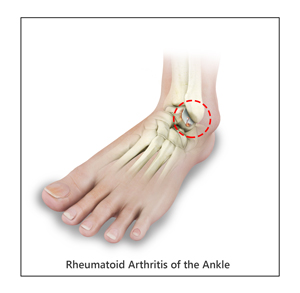
What is Ankle Rheumatoid Arthritis?
Arthritis is inflammation in a joint as a result of cartilage degeneration causing joint pain, swelling, stiffness, and restricted movement. Arthritis of the foot and ankle joint can occur due to fractures, dislocation, inflammatory disease, or congenital deformity. The foot joints most commonly affected by arthritis are:
- The joint between the shinbone (tibia) and ankle bone (talus)
- The three joints of the foot that include the heel bone, the inner mid-foot bone, and the outer mid-foot bone
- The joint of the great toe and foot bone
Rheumatoid arthritis is an auto-immune disease in which the body’s immune system (the body’s way of fighting infection) attacks its own healthy joints, tissues, and organs. It can cause pain, stiffness, swelling, and loss of function in the joints. Rheumatoid arthritis affects mostly joints of the hands and feet and tends to be symmetrical. This means the disease affects the same joints on both sides of the body (ex. both feet) at the same time and with the same symptoms.
Causes of Ankle Rheumatoid Arthritis
Rheumatoid arthritis is often caused when the genes responsible for the disease are triggered by infection or environmental factors. With this trigger, the body’s defense mechanism produces antibodies against the joint which may lead to rheumatoid arthritis.
Symptoms of Ankle Rheumatoid Arthritis
Symptoms of ankle rheumatoid arthritis include difficulty climbing stairs and with inclines. With the progress of the disease, even simple standing and walking becomes painful.
Diagnosis of Ankle Rheumatoid Arthritis
The diagnosis of ankle rheumatoid arthritis is made with a medical history, physical examination and X-rays of the affected joint. A bone scan, computed tomography (CT) scans, and magnetic resonance imaging (MRI) scans are also performed to make a diagnosis.
Treatment Options for Ankle Rheumatoid Arthritis
Non-surgical treatment options for ankle rheumatoid arthritis include rest, application of ice, medications (anti-inflammatories), injections (steroids), orthotics, or braces to support the joints.
Surgery may be required if your symptoms do not improve with conservative treatments. Ankle joint replacement and ankle fusion are two surgeries for treating ankle rheumatoid arthritis. In ankle joint replacement, your surgeon removes the damaged ankle joint and replaces it with an artificial implant. The goal of ankle replacement is to relieve pain and restore normal joint function. Ankle fusion is the procedure of fusing two bones to make one bone. This limits joint motion, thereby reducing pain.

